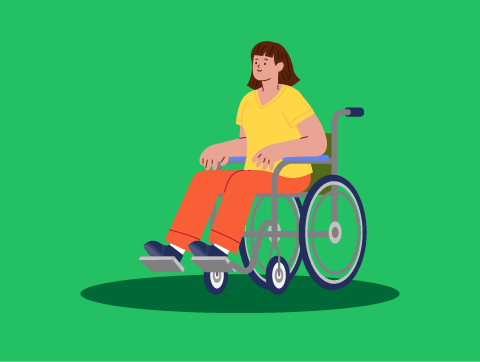Introduction
Digital systems need to be used by an end user, which could be an employee or a member of the public.
Users will have basic expectations of the system, which are defined in terms of their needs—that is, what they want the system to do.
The system will also need to cater to the type of user and their different characteristics, which will determine their ability to use the software or access the service.
In this lesson, we’ll learn about:
- How digital systems are used to meet user needs and ensure the quality of a product/service
- Understand how the characteristics of users affect the use of the digital product

Meeting User Needs
Some of the ways technology can be used to meet user needs and guarantee quality include:
- Appropriate & effective functionality
- Reduction of pain points
- Accessibility considerations
- Compatibility
- Availability
- Good user experience
- Cultural awareness & diversity
Let’s look at each of these in more detail.

Appropriate & Effective Functionality
For a product or service to do well, it needs to work well and provide the features we require to perform our tasks.
For example, an organisation might want to keep accurate records of its finances, which it can do through the use of an appropriate accounting software package.
It’s not just in providing specific functionality that technology helps us, though. Technology can make it easier to get feedback from people who use your product or service.
This feedback can help you make improvements and changes to ensure the functionality is improved and more closely meets their needs.

Reduction of Pain Points
Pain points are anything that causes us stress or frustration when we use a product or service.
Technology can help us identify and fix those pain points so users have a more positive experience.
Improved communication is one way digital can help with this, such as through chatbots and CRM software.
Another way it can help is through personalisation, such as by customising an interface to a user’s individual needs or dynamically displaying content based on previous interactions (e.g., showing related products to previous purchases).

Accessibility Considerations
Digital technology has made it easier for people with disabilities to access information, products, and services.
For example, text-to-speech software can read aloud websites and documents for visually impaired people, and screen readers can help people who are blind navigate around digital interfaces.
Additionally, many digital products and services have features that make them more accessible to people with different abilities, such as zoom functions that make text larger or audio controls that allow people to adjust the volume.

Compatibility
It’s important to consider compatibility when developing digital products – will they work on all devices and operating systems?
By considering these things, we can create products that everyone can enjoy.
Digital technology has helped ensure compatibility in digital products and services by allowing developers to create products that work on various devices and operating systems.
For example, modern game engines have made it easy to port games to different platforms without having to heavily redevelop the game.

Availability
This is about the ability of an individual to access a product or service at any given time. Digital technology can help businesses make sure that their products and services are available whenever and wherever people want them.
For example, businesses can use online platforms like websites and cloud technology to make it easier for people to get what they need.
If you store your files on a cloud storage service like OneDrive, then you’ll be able to access them on any computer as long as you have an internet connection.
Digital technology has also improved availability in terms of delivering physical products.
Online shopping, automated stock control systems, and GPS technology have made it quicker and easier for people to shop and companies to deliver.

Good User Experience
This is about the overall experience an individual has when using a product or service. It requires the product/service to give an easy and enjoyable experience when it is used.
Digital technology can help achieve this through personalisation. By using advanced algorithms and analytics, we can understand our customers and adapt to their individual needs.
This might be by showing content we know they’re interested in.
Some other ways it can help improve the user experience is through simplifying tasks through automation, providing clear feedback to understand what they’re done right/wrong, and using adaptive technology to be more accessible.

Cultural Awareness and Diversity
Digital technology has helped to ensure cultural awareness and diversity in digital products and services by making it easier for people to connect with others from around the world.
Through social media platforms, users can communicate with others from different cultures, learn about their customs and traditions, and even collaborate on projects.
This has led to a more culturally diverse world online, where people can interact and learn from each other more meaningfully.
Another aspect of cultural awareness and diversity through digital systems is how systems can be easily adapted to other cultures.
Languages can be changed quickly, user interfaces can change to meet cultural experiences (e.g., right-to-left text rather than left-to-right), and colours can be adapted according to individual cultural standards.

How User Characteristics Affect Digital Product Use
The individual characteristics of our end users can impact the technology they use. These characteristics include:
- Age
- Skills
- Education level
- Internal/external audience
- Level of technical knowledge
- Additional needs
Let’s look at each of these characteristics & their impact in more detail.

Age
Different age groups tend to use different technologies in different ways.
For example, younger users are generally more comfortable with newer, more complex technologies than older users. They’re also more likely to be early adopters of new technologies.
On the other hand, older users may prefer more traditional methods or be less comfortable with change.

Skills
Different people have different skill sets, which can affect their ability to use certain technologies. It will also affect their confidence when faced with new technology to learn it.
For example, someone who is not very good at using computers might have difficulty using an app that requires a lot of computer skills and would find it more difficult to learn to use it.

Education Level
The education level of end users can also affect how they interact with digital technologies. This might be whether someone is educated up to further education, higher education, or post-graduate level.
For example, someone with a higher education level might be more comfortable using complex websites or apps than someone with a lower education level.

Internal / External Audience
Internal audiences are employees or other members of an organisation. External audiences are those from outside the organisation, such as customers.
You might use a more complex technology for an internal audience, as you can assume they already have some background knowledge but opt for a simpler technology for an external audience that doesn’t have much knowledge about your organisation.

Level of Technical Knowledge
Technical knowledge is the specialised skills for a particular industry. For example, the ability to program in the IT industry.
Users with low technical knowledge levels may be more comfortable using simpler technologies, while users with high technical knowledge levels may be more comfortable using more complex technologies.

Additional Needs
If your target audience includes people with disabilities, you’ll need to ensure that any technology you select is accessible to them.
Of course, there is a wide range of different disabilities that require different adaptations. Some examples include:
- Sight loss – we can adapt to this audience through text-to-speech software.
- Hearing loss – we can adapt to this audience by ensuring subtitles are provided for any audio or video.
- Colour Blindness – we can adapt to this audience through a customisable colour palette.
- Severe Mobility Issues – we can adapt to this audience through compatibility with devices such as eye controllers.

Lesson Summary
Digital technology helps to create appropriate and effective functionality for products and services.
Some of the ways technology can meet user needs include having appropriate & effective functionality, reducing pain points, being accessible, being compatible, being available, having a good user experience & showing cultural awareness & diversity.
The individual characteristics of our end users can impact the technology they use.
These characteristics include age, skills, education levels, internal/external audience, level of technical knowledge & additional needs.
